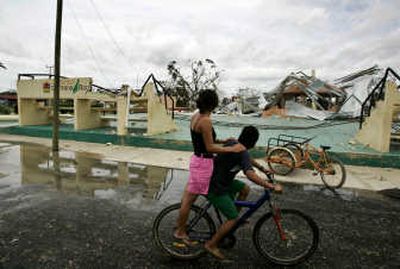Damage modest despite Dean’s force

CHETUMAL, Mexico – Hurricane Dean wasn’t through with Mexico, not in the least, but this didn’t seem possible:
A Category 5, record-book hurricane – the most powerful to strike land since Andrew whacked South Florida – and it didn’t flatten Anita Lara’s tin-and-wood house just four blocks from the Bay of Chetumal.
No reports of storm-related death or serious injury surfaced Tuesday in Mexico’s Yucatan Peninsula, which also didn’t seem possible. A full assessment of remote areas will take days.
And there it was, this truly humble home, a little worse for its encounter with Dean but still erect Tuesday as Lara surveyed the wet, wind-blown but mostly intact landscape.
Even the kitchen glasses survived, uncracked despite Dean’s screaming, pulsing winds, which reached 165 mph a little farther up the coast.
“It stayed cute, didn’t it?” Lara, 54, said of her house. “To tell you the truth, I thought the whole thing would be gone.”
Dean weakened considerably late Tuesday as it completed its assault on the sparsely populated section of the low-lying Yucatan, but Mexico’s trial by nature persisted.
The once-savage storm rolled over the warm water of the Bay of Campeche and was expected to reintensify before reaching land again today, possibly between Tuxpan and Veracruz.
Among the threats: flash floods and mudslides in the mountains of Mexico and Guatemala, likely to be inundated with torrential rain – up to 20 inches – in the days ahead. Inland flooding is one of the leading causes of hurricane-related deaths.
“Dean could approach major hurricane status again,” said hurricane specialist James Franklin of the National Hurricane Center.
So far, though, the news was surprisingly good, the toll remarkably modest, considering Dean’s potentially destructive power.
Some areas flooded, many structures were damaged or collapsed, thousands of trees were toppled.
But Mexican President Felipe Calderon said he had no reports of storm-related deaths and power should be restored within days.
In neighboring Belize, also hit by the storm, trees fell and debris flew through the air, but, again, no early reports spoke of sweeping damage.
Dean’s core roared ashore before dawn at the port of Costa Maya near Majahual, about 150 miles south of Cancun.
It was the most intense storm to make landfall since Andrew steamrolled south Miami-Dade County in 1992. It also was the third most intense Atlantic basin hurricane to reach land in history.
Along with howling wind, Dean produced considerable rain in the Yucatan and a seawater surge 12 to 18 feet high.
A storm of this magnitude can be life-threatening and is certain to deliver catastrophic ruin to anything that stands in the path of its eye wall.
In this case, not much did.
In a major stroke of luck, the tourist centers of Cancun and Cozumel, well to the north, were spared Dean’s worst winds.
“Cozumel is ready to go,” said Gustavo Ortega, the tourist-friendly mayor of the popular cruise ship destination.
Instead, the storm carved a path through a mostly undeveloped region of villages, ancient Mayan ruins and jungles.
In addition, Dean moved quickly – at a forward speed of 20 mph – not lingering long enough to commit all the mayhem of which it was capable.
Dean’s prolonged encounter with land weakened it to Category 1 status by midday Tuesday, though it still swept the Bay of Campeche with high winds.
Many oil rigs and related facilities stand in and around the bay like targets on a firing range.
But the primary concern always is human life, and Dean already killed at least 13 people in Jamaica, Haiti, the Dominican Republic and elsewhere.
Mexican officials fear that the toll could grow as Dean crosses the bay, strikes land again, moves inland and rains and rains and rains on those mountains and valleys.
Back in Chetumal, a city of 125,000 people that nearly sustained a direct hit, the damage seemed significant but hardly catastrophic.
Heavy water tanks flew off rooftops, billboards spun down streets during the storm and hundreds of trees and fallen streetlights partially blocked access to the city center. Gas stations and other small buildings lost their roofs; some older structures collapsed.
But afterwards, residents quickly began clearing debris.
Power crews worked to restring dangling lines. Soldiers with machetes hacked at tree limbs to clear them from the roads. Refugees, those few who left their homes, returned to relatively undamaged structures.